There are hundreds of types of spiders in New York. Most of these spiders are harmless but most people are afraid of them anyway. Each spider is different and it takes minimum knowledge to identify each species.
Here are a few characteristics of the most common New York spiders.
Table of Contents
1. Bold Jumping Spider
Scientific name: Phidippus audax.
Common name: daring jumping spider, bold jumping spider.
Common on house walls, the Bold Jumping Spider lives on flat surfaces. This allows this fast spider to catch its prey efficiently. Unlike other spiders, it doesn’t weave a web. Jumping on insects is the main hunting method of this spider.

Bold Jumping Spiders can be easily identified in New York gardens and around households based on their black color. Their thick black bodies often have white stripes (or sometimes yellow stripes and marks).
The average male Bold Jumping Spider measures 8mm. The female is larger normally measuring around 11mm.
2. Yellow Garden Spider

Scientific name: Argiope aurantia
Common name: yellow garden spider, black and yellow garden spider, golden garden spider, writing spider, zigzag spider, zipper spider, black and yellow argiope, corn spider, Steeler spider, McKinley spider.
This spider species is very common in gardens, orchards, or natural green habitats around homes. Unlike the Bold Jumping Spider, the Yellow Garden Spider weaves a zig-zag web. The female spider can be seen on this web most of the time.
Yellow Garden Spiders use venom to immobilize prey caught up in the spider web. It’s believed this venom has some medical use, but it’s not dangerous to humans.
You can recognize these spiders by their large black and yellow bodies which can sometimes measure up to 28mm.
The spiders prefer clear locations where they can easily escape in case they sense danger but they tend to bite if threatened.
3. Orchard Orbweaver

Scientific name: Leucauge venusta.
Common name: orchard orbweaver.
The Orchard Orweaver lives in shrubs, grass, and woodlands. It’s recognized by its long green legs, long jaw, and a stripped elongated body. This spider has a balanced temperament not being aggressive towards humans.
It builds spider webs of a circular pattern. These are hung horizontally so the Orchard Spider sits upside down right in the center of the web. It awaits small insects and leaf insects that make up the bulk of its prey.
The spider prefers small prey as it’s a small spider. The male reaches 4.5mm while the female can grow up to 7.5mm.
4. Zebra Jumping Spider

Scientific name: Salticus scenicus.
Common name: zebra jumping spider.
The Zebra Jumping Spider is agile based on its lateral eyes. Using good vision it manages to get close to its prey. This hunting spider always needs to be close enough before attacking its prey. The Zebra Jumping Spider has been particularly known for attacking mosquitoes.
This spider gets its name from its stripped look. The hairy spider is also known for its dancing nature which also inspired its name. The male of the species performs a complex dance in front of the female as part of the mating process.
5. Spotted Orbweaver

Scientific name: Neoscona crucifera.
Common name: Hentz orbweaver, spotted orbweaver, barn spider.
Individuals from this species are brown with various coloration influences. Brown and orange and brown and yellow are its most common nuances. These spiders are known for having bristles all over the body and this includes the legs.
As an orb spider, the Spotter Orbweaver weaves large webs. It doesn’t stay on the weave itself like the Orchard Orbweaver as it prefers to hide nearby.
While the spider appears large, it has a range of natural predators. Its hundreds of spiderlings are the prey for large wasps and the Spotter Orbweaver can be overprotective of spiderlings as a result.
6. Tan Jumping Spider

Scientific name: Platycryptus undatus.
Common name: tan jumping spider.
The Tan Spider uses a dragline to entangle its prey. It hunts and jumps on its prey like many other jumping spiders. This individual can jump long distances. It normally jumps a distance equivalent to 4-5 times its body length.
The spider prefers to hide when not hunting. It hides under leaves or it creates a shelter from leaves and debris to hideaway.
It’s also believed the Tan Jumping Spider does not live in solitude as much as other spiders. It hibernates with other Tan Jumping Spiders during the winter.
7. Dark Fishing Spider

Scientific name: Dolomedes tenebrosus.
Common name: dark fishing spider.
Spiders of the species can reach 26mm for females and 13mm for males. You can recognize these spiders by their brown color and distinct chevron marks on their body. However, this spider is difficult to spot in its preferred habitat, the woodlands.
These spiders aren’t considered dangerous to humans. Since they live out in nature far from the human activity they prefer to hide when they see humans. However, they can bite humans on occasion. Bites from this spider have been reported in the US and Canada.
8. American Nursery Web Spider

Scientific name: Pisaurina mira
Common name: American nursery web spiders.
The American Nursery Web Spider is a popular Wolf spider in the Eastern part of the country, including New York.
This brown spider is an avid hunter that prefers to live in woodlands and tall grass fields. The brown spider uses tall grass to hide and to pounce on its prey like a true hunter.
This spider is also known for its cannibalistic nature. The female American Nursery Web Spider eats the male after reproduction given the chance. As a result, the male uses various techniques to avoid being eaten alive by the female after reproduction.
9. Cross Orbweaver

Scientific name: Araneus diadematus.
Common name: European garden spider, diadem spider, orangie, cross spider, crowned orb weaver, pumpkin spider.
This species of spider lives in gardens, parks, and woodlands. It gets its name from the white cross mark on its body. The cross is made up of dots and dashes and it allows quick species identification. The spider isn’t dangerous to humans.
Since it made its way to the US from Europe, this spider retains the same habitat and prey preferences as its European counterpart. It prefers to sit on the spider web only dropping to the ground in the presence of danger as a means of self-defense.
10. Northern Yellow Sac Spider

Scientific name: Cheiracanthium mildei.
Common name: Northern yellow sac spider.
The Norther Yellow Sac Spider has a pale yellow-tan color. It’s easily spotted on leaves due to the obvious color contrast.
This spider is one of the potentially dangerous species to humans in New York. If bitten, you will feel pain as its venom is quite potent.
The species has also been problematic for car owners in the state. Some sub-species of the Northern Yellow Sac Spider are attracted by the smell of gasoline. This is why they often cause serious fuel blockages as they build their webs in fuel canisters.
11. Furrow Orbweaver

Scientific name: Larinioides cornutus.
Common name: furrow spider, furrow orb spider, foliate spider.
This spider is firstly identified by its bulbous abdomen. The color can vary largely from one individual to another making correct identification troublesome for some. Its color can range from black to red. The bulbous abdomen and the legs are colored in the same nuance.
This spider prefers to live near sources of water. It has very good cold temperature adaptation meaning it doesn’t hibernate during the winter. This spider is also believed to have the ability to sense sounds, mainly using its macrostate hairs on the legs.
12. Spined Micrathena

Scientific name: Micrathena gracilis.
Common name: spined micrathena, castleback orbweaver.
This spider is instantly recognizable by its white spiked body. It can be one of the most interesting species to look at as it has an irregular body shape. The spider spin webs and the males can produce silk as well. It’s believed this silk is only used during the mating ritual.
Individuals live around one year. The female lays an egg sack at the end of the summer to mark its reproductive season. Unlike the Furrow Orweaver, the Spined Micrathena spider enters hibernation and remains dormant during the winter.
13. Eastern Parson Spider

Scientific name: Herpyllus ecclesiasticus.
Common name: Eastern parson spider.
This spider is one of the fastest in New York. It’s almost impossible to catch due to its speed. But it can be recognized by the cravat markings on its body which resemble ecclesiastic hats of the past.
The spider is mostly spotted during the summer in the state.
There’s another spider that looks almost exactly like the Eastern Parson Spider. The Western Parson Spider lives on the West Coast and there are no major physical differences between these species. The only differences can be spotted under a microscope.
14. Woodlouse Spider

Scientific name: Dysdera crocata.
Common name: woodlouse hunter, sowbug hunter, sowbug killer, pillbug hunter, slater spider.
This spider is particularly interested in hunting woodlice. This is why it can be found in homes or areas with plenty of woodlice. It prefers to come out and hunt at night since it doesn’t spin a spider web.
While it can appear just like any other spider, it’s quite aggressive. It might not be dangerous to humans but the Woodlouse Spider is dangerous to its species.
These spiders often injure themselves during the mating process. Its aggressive nature can sometimes be seen in its hunting habits. This spider sometimes kills other spiders given the chance.
15. Long-bodied Cellar Spider

Scientific name: Pholcus phalangioides.
Common name: daddy long-legs spider, long-bodied cellar spider, skull spider.
These long spiders are identified by their grey bodies. Sometimes called the Skull Spider, the Long-bodied Cellar Spider is one of the most popular spiders as it’s believed to be on almost every continent.
This spider also has a distinct habitat and mating ritual. Some male Long-bodies Cellar Spiders are eaten by the female during the courting process. It’s believed females wrongly see males as prey. It’s also believed males tend to pounce on the female’s spider web to create specific vibrations that identify them as males. There’s a high chance of cannibalization when these vibrations aren’t properly understood.
16. Common House Spider

Scientific name: Parasteatoda tepidariorum.
Common name: common house spider, American house spider.
These spiders are most common inside New York homes. They live in proximity to humans and they aren’t dangerous. These spiders rarely bite humans. It’s believed you can only trigger a bite when squishing these spiders between the fingers.
Females and males live on the same spider web, a rare occurrence in the spider world. For males, it’s important to live in peace with the female. However, other females can create spider webs nearby which normally triggers aggressiveness between the females.
Both the female and the male spiders of the species can vary in color. They can be brown or near black in body and leg coloration.
17. Marbled Orbweaver

Scientific name: Araneus marmoreus.
Common name: marbled orbweaver, pumpkin spider.
This popular spider gets its name from resembling a small piece of marble. Its brown body is colored with white or yellow markings similar to a small marble piece.
The spider is not dangerous as it doesn’t cause an allergic reaction in humans. Its bite can be painful, however.
The pain of a Marbled Orbweaver’s spider is often compared to the pain associated with a bee sting. Bites are rare since the spider mostly lives on its spiderweb.
18. Flea Jumping Spider

Scientific name: Naphrys pulex.
Common name: Flea Jumping Spider.
This spider species is popular but it lacks a full understanding. The description of an agile black and grey spider mostly refers to male Flea Jumping Spiders as the females of the species are rarely seen.
However, it’s a known fact that these are small spiders as they measure anywhere between 7 and 10 mm in adulthood.
A good hunting capacity described these spiders the best. They can find food out in the wild as a result. Like many good hunting spiders, the Flea Jumping Spider has excellent vision. It’s believed that this vision puts it among the most efficient hunting spiders of a small size.
19. Asiatic Wall Jumping Spider

Scientific name: Attulus fasciger.
Common name: Asiatic Wall Jumping Spider.
This wall spider prefers to live on buildings, particularly on walls. It’s believed it lives on walls as it finds it easy to pounce on prey from this flat vertical surface.
It wasn’t found in New York as other native species. It was introduced in the country only a few decades back.
Since the spider is small it can be hard to see on a gray wall. However, its gray color with gray markings might make it distinguishable on a contrasting color wall.
You can distinguish these spiders from other household spiders by their size. The male is never larger than 4.5mm. The female grows to a maximum size of 5.5mm.
20. Banded Garden Spider

Scientific name: Argiope trifasciata.
Common name: banded garden spider, banded orb weaving spider.
These large spiders are easily seen in early fall. They appear just as the temperature starts to drop and they can easily be found as they create some of the largest spider webs.
The Banded Garden Spider is easily spotted in gardens and parks as both the female and the male spin webs. A smaller spider web in the proximity of the larger spider web is an indication of the presence of the male Banded Garden Spider.
These spiders have perfected some of the most robust spider webs. The silk used to make the webs contains stabilimenta. This means they are stronger and they can resist larger insects, flies, and birds flying into them.
21. Goldenrod Crab Spider

Scientific name: Misumena vatia.
Common name: goldenrod crab spider, flower (crab) spider.
The Goldenrod Crab Spider is one of the New York spiders that live on and around fragrant flowers. You can recognize this spider by its white or yellow body. With the ability to move sideways, the spider resembles crabs.
Females of the species are larger than males. They tend to live on the flowers that smell the most as these attract plenty of insects seen as prey. Female spiders rarely move far from their chosen flowers or living area, unlike the male that travels long distances for mating.
Flies, bees, and even large butterflies are seen as ideal prey by both the male and the female.
Further Reading:
22. Striped Fishing Spider
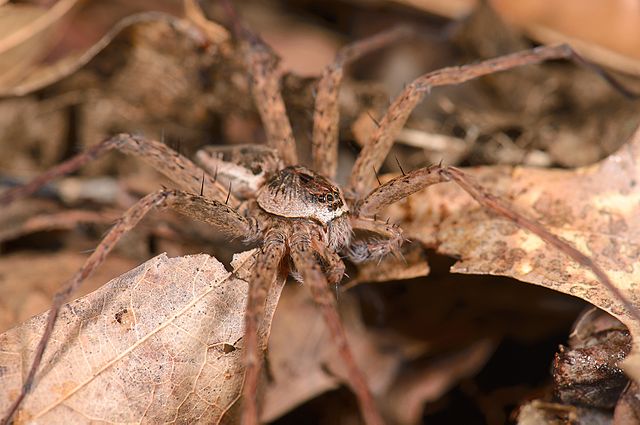
Scientific name: Dolomedes scriptus.
Common name: Striped fishing spider.
These large spiders can grow to a maximum size of 5.9 inches. They are characterized by a pale brown color with stripes and marks on the body and on the legs.
Most people know these spiders for being venomous. However, considerable reactions are rare.
These spiders live up to a year, depending on the food they find. They typically eat small insects which they often feed their spiderlings.
23. Bronze Jumping Spider

Scientific name: Eris militaris.
Common name: bronze jumper or bronze lake jumper.
This jumping spider is known for its bronze bands that run along its body. It’s one of the most aggressive spiders found throughout the country. It’s one of the few spider species present in every state. This species is believed to be quite aggressive.
The bite of the spider is not venomous. It doesn’t cause a bad medical reaction in most people. However, the initial period after the bite is when people can feel a sharp pain in the area of the bite.
24. Golden Jumping Spider
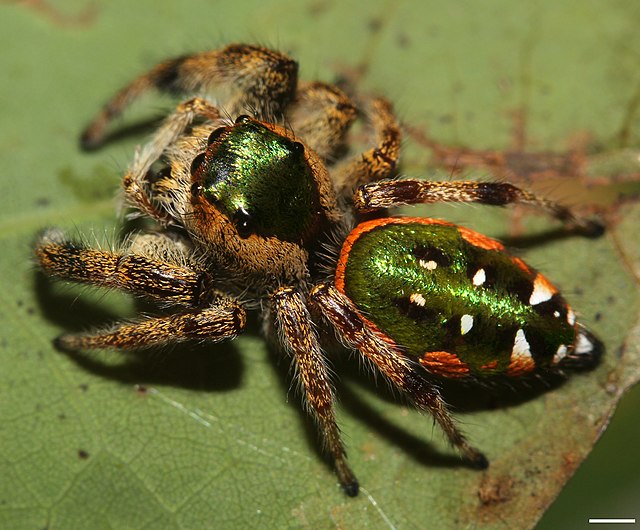
Scientific name: Paraphidippus aurantius.
Common name: emerald jumping spider, golden jumping spider.
This jumping spider is known for its golden color with black, green, and white marks.
It lives in homes and around homes where it finds house pests as ideal prey. This spider is well-accustomed to humans.
It’s believed it only rarely attacks people. Its bite is quite painful but it’s not followed by a serious health reaction.
25. Triangulate Combfoot

Scientific name: Steatoda triangulosa.
Common name: triangulate cobweb spider, triangulate bud spider.
This spider species also live inside homes, similar to the Golden Jumping Spider. You can find the Triangulate Combfoot spider behind furniture. It’s here you’ll find its egg sacs during the summer months as well.
The spider can be recognized by its small body. It grows to 7mm in adulthood. But the small triangle marks on its body are what set this spider apart the most for easy recognition.
26. Dimorphic Jumping Spider

Scientific name: Maevia inclemens.
Common name: Dimorphic Jumping Spider.
The Dimorphic Jumping Spider is recognized by its multiple colors, often a combination of green, white, black, and yellow. Female spiders are known for having a white face which makes recognition easier. These small spiders tend to be hard to predict in looks as spiderlings.
Dimorphic Jumping Spiders are easily found in nature, particularly on Ivy. They are generally seen as beneficial as they eat all types of insects. However, these small spiders also have a lot of predators, even from the spiders’ world. Wolf spiders continuously attack Dimorphic Jumping Spiders.
27. Broad-Faced Sac Spider

Scientific name: Trachelas tranquillus.
Common name: broad-faced sac spider.
These spiders are recognized by their gray bodies, brown legs, and by their dark grey heads. They are often seen with what appears as small punctures on their bodies.
The spiders are known for living in dry habitats. This includes leaves, garages, and homes.
The bite from the spider is painful, often followed by complications. A common complication is an infection. It’s believed this spider’s bite is always followed by an infection in the area of the bite. It requires medical attention.
28. Grey Cross Spider

Scientific name: Larinioides sclopetarius.
Common name: bridge spider, gray cross spider.
These spiders are also highly common in New York. They can be seen as urban spiders as they’re rarely seen out in nature. They prefer dry and lit areas of the city. You can see them under bridges, particularly bridges with light bulbs where they await prey.
The spiders don’t wander off too far from this habitat as they weave webs. They hide during the day and they come out during the night when there are high chances of a light bulb attracting insects to get caught up in the spider web.
29. American Green Crab Spider

Scientific name: Misumessus oblongus.
Common name: American Green Crab Spider.
This popular spider is part of the Aranae family. You can easily recognize it by its translucent green body and legs. However, you might not easily spot the spider in its natural habitat as its often camouflaged on green leaves.
Its crab name comes from its legs which are pointing outwards. These legs allow the spider to easily move sideways, just like a crab. The legs of the spider can sometimes have colored markings on them, making the spider a bit easier to spot on green leaves or in the grass.
Further Reading:
30. Wetland Giant Wolf Spider

Scientific name: Tigrosa helluo.
Common name: Wetland giant wolf spider.
This spider has a dark gray body and translucent brown legs. It’s a type of avid hunter, just like most other Wolf spiders.
While not the largest Wolf spider, it’s still a good hunter, particularly in areas with high humidity. This includes areas around rivers and lakes, as well as sewers.
The spider lives most of its life in solitude and it tends to meet other Wetland Giant Wolf Spiders in the mating season only.
31. Myrmarachne formicaria
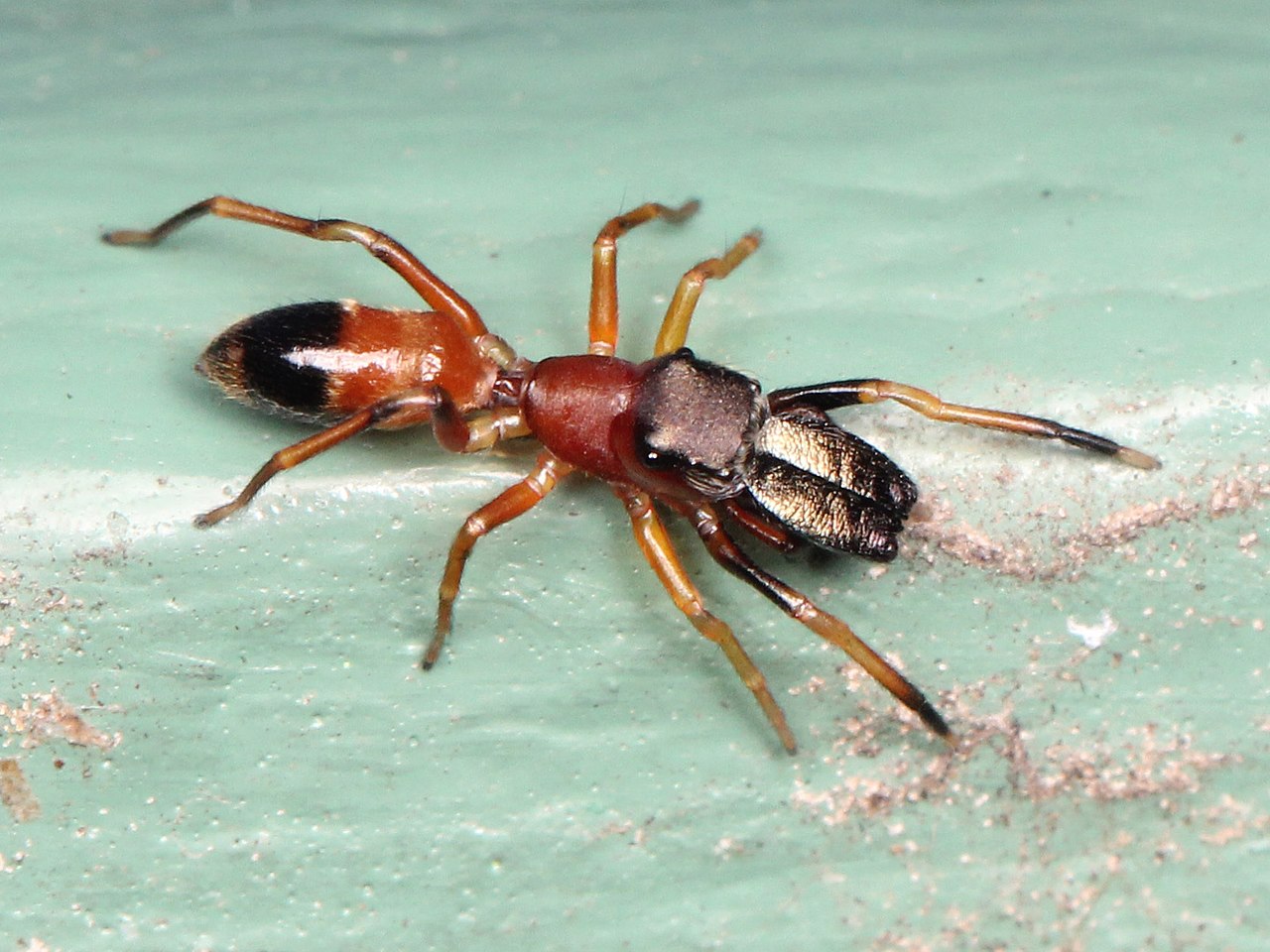
This unique species of spiders are almost impossible to miss. Most people would wrongly identify it as a giant ant. But the spider is a true jumping spider that only looks like an ant.
Its formicaria name comes from the Latin word ‘ant’ given its impressive resemblance. However, this spider has no other ant attributes apart from its looks. It is, however, a very good hunter, just like many other jumping spiders.
Futher Reading:
32. Arabesque Orbweaver

Scientific name: Neoscona arabesca.
Common name: Arabesque Orbweaver.
This black spider has distinct bright markings on its abdomen.
It’s a non-aggressive spider as are other orbweavers. However, it’s one of the spiders that are very active at night. It comes out to create and repair its spider web during the night.
The spider is never seen during the day as it prefers to hide away in cracks, leaves, or under rocks, typically close to its spider web.
33. Black-palped Jumping Spider

Scientific name: Pseudeuophrys erratica.
Common name: Black-palped Jumping Spider.
This black and yellow spider is believed to originate in Europe. Early reports of its US existence were heard in the ‘80s. Today, it’s believed this spider is present both on the East Coast and on the West Coast.
You can sometimes find the male Black-palped Jumping spider under rocks and on the ground, particularly in forests or around trees.
34. Six-spotted Orbweaver

Scientific name: Araniella displicata.
Common name: Six-spotted orb weaver.
This spider species is synonymous with sunflower. It looks and loves to live on sunflowers, a natural habitat filled with nectar that attracts all types of insects as perfect prey. The spider is brown and yellow or brown and white.
However, there’s a difference in where these species live. The brown and yellow Six-spotted Orbweaver lives in fields on flowers such as sunflowers. The brown and white Six-spotted Orbweaver lives in wodolands.
35. Peppered Jumping Spider

Scientific name: Pelegrina galathea.
Common name: peppered jumper.
This North American endemic spider species is recognized by its black body and white marks. The marks are present both on its body and its legs.
It’s a type of spider that has excellent vision. This allows the jumping spider to accurately pounce on its prey.
You can see this spider in broad daylight, particularly on the ground in the grass.
36. Shamrock Orbweaver
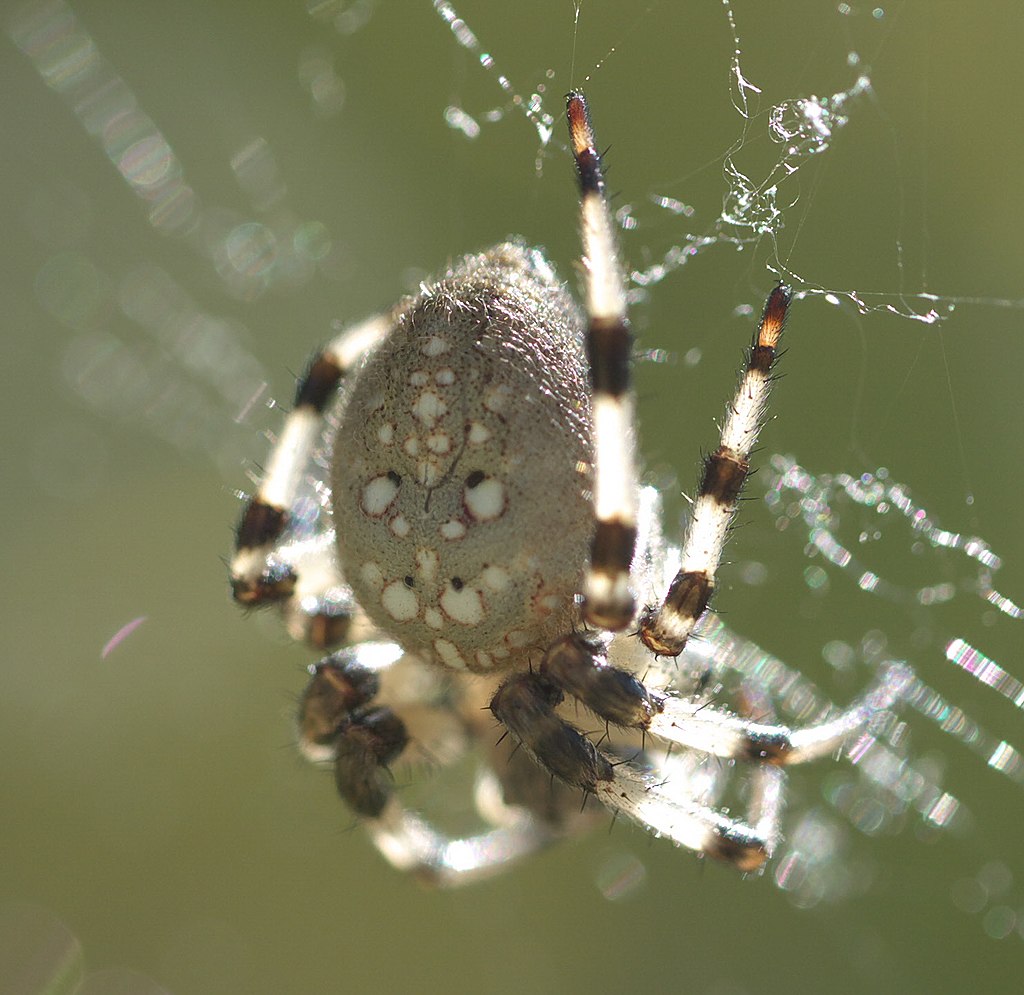
Scientific name: Araneus trifolium.
Common name: Shamrock orb weaver.
Part of the Araneus genus, the Shamrock Orweaver is a brightly colored spider. It has distinct grey-green or yellow-orange bodies with short thick legs that are often filled with white markings. The spider also has a few dots on its back which separates it from other orbweavers.
Its habitat is out in nature where it uses a spider web to catch flies and insects. Its spider web is large, just as with other orbweavers. The largest Shamrock Orbweaver spider web measures approximately 2 feet in diameter.
37. Six-spotted Fishing Spider
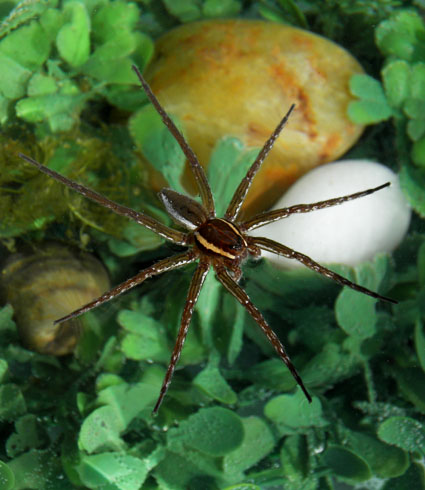
Scientific name: Dolomedes triton.
Common name: six-spotted fishing spider, dock spider.
This spider lives in wet areas, particularly in areas with streams, lakes, and rivers. It gets its name from the Greek god Triton, a god of the sea.
The spider is all-black both on the body and on the legs. It only has 2 white stripes that run alongside its body.
Its habitat is largely aquatic. It’s here that the Six-Spotted Fishing spider likes to hunt. It eats all types of small fish. Some of the fish it preys are a few times larger than its body size.
Further Reading: